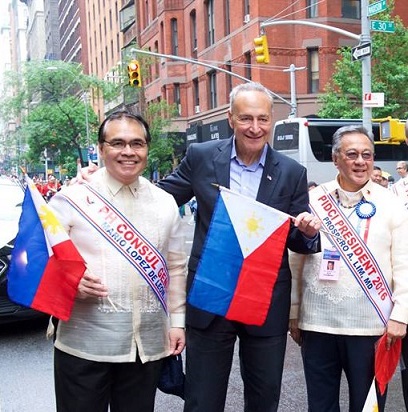‘I march in Gay Pride so that some in Filipino community will not ignore, make fun of us’
By Noel BordadorThirty years ago years when I first marched in New York City’s Pride parade, I just barely came out. I was 18, and it was a year of intense emotional and spiritual struggle.
A gay Jesuit priest and a counselor at the Gay Switchboard of New York helped me come to terms with who I am. I linked up with a spiritual support group and found friends who asked me to watch the Pride parade even though I had no intention of marching. Coming out to myself and a few gay friends was one thing, but coming out to the “world” was another. I wasn’t out to my family then. Besides, I was an undocumented immigrant, and I couldn’t afford to be too visible.
On that sunny day of June in 1983, I met up with some friends at Columbus Circle. I was surprised to see the thousands of LGBTQs who came to watch and to march. Many were carrying large pictures of famous LGBTs throughout history. Many were carrying placards identifying who they were: “Father,” “Sister,” “Doctor,” “Minister,” etc.
Suddenly I no longer felt so alone. I felt that I belonged to a larger community. It was the sight of those thousands of people that made me move from the curb to the streets. For a moment there I felt like I just took off my clothes in the middle of Fifth Avenue. That was how vulnerable and exposed I felt when I marched for the first time. But it also felt very freeing to affirm myself for who I am, and to claim pride in my identity.
It was after that first march that I entertained coming out to my family. I knew I was “different” since I was 3, because people around me noted my “girlish” ways. In my early teens I recognized an attraction to men but ignored these feelings until I was 17 when I could no longer. I sought help because of depression and may have entertained thoughts of ending my life.
But it took years, 14 years to be exact, for me to come out to my parents. It wasn’t easy for them nor for me. My conservative religious mother particularly took it really hard because she thought that my being gay endangered my relationship with God. I wouldn’t say that my parents had overwhelmingly come to embrace my identity with the pride and joy, but at least they didn’t reject me and they have met my spouse several times and welcome him. But we don’t speak about my gay identity or my relationship. My siblings, on the other hand, have accepted our relationship. They treat us as a couple.
My first Gay Pride parade was a militant civil rights gathering. It wasn’t anything like the party-themed parade, corporate-sponsored celebration we have now. We didn’t have celebrities like Lady Gaga or Cher. There were no pandering mayoral candidates and politicians.
The Stonewall Rebellion that sparked our the LGBTQ civil rights in late 1969 had occurred 14 years earlier, and homosexuality was just declassified as a form of mental illness 10 years earlier. Our movement was still young and marginal. We marched for visibility and to fight for equal rights. Many states still criminalized homosexuality at the time as the Supreme Court made the move to decriminalize homosexuality only in 2003. There was no legal protection against discrimination. In New York State, that legal protection came only in 2003. There was no serious talk of same-sex marriage yet. But that march planted the seeds of political activism in me that came to grow later.
It was the beginning of HIV/AIDS, and people didn’t know much about the epidemic. But the LGBTQ community was not paralyzed by fear. We had to deal with friends dying left and right, friends who suffered discrimination and rejection even by their families. Because of the government’s slow response to the epidemic, the LGBTQ community began to mobilize politically. The LGBTQ also formed many social services organizations to care for its vulnerable members. It was then I saw that tender and human side of the LGBT community to come together to take care of our own when no one else seemed to care.
I saw a sprinkling of Asians then. Today, the Asians and Pacific Islanders are visible. There wasn’t a Philippine contingent then. The first NYC LGBTQ Philippine group – Kambal sa Lusog — was founded eight years later. The first Philippine lesbian organization in the U.S., Kilawin Kolektibo, was also formed in the mid-1990s. Both have since disbanded. Currently, we have Bayan USA/ Queer Caucus and the fragile Barangay New York which are the only Philippine LGTB organizations in New York.In 1983 the largest contingent of Asians was that of Asian lesbians called Asian Lesbians of the East Coast, which disappeared in the early 1990s. I recently met someone who knew one of the Pinays founders, Chea Villanueva, who is now in her 60s and lamenting how the older generation is invisible in the movement. We have arrived at this point of our history because of the early pioneers.
Sometimes, many in the LGBTQ community tend to focus on identity concerns only. The community still needs to be intentional in forging an alliance with all sectors — LGBTQ and non-LGBTQ — of our society yearning for justice. I march to render us visible to the larger Philippine community that tends to ignore, make fun and marginalize us. Though we have certainly come a long way and gained many civil rights, the fight for equality is far from over.
A graduate of social work from Hunter College, Noel Bordador works as an HIV outreach worker. He studied at the General Theological Seminary in Manhattan.













